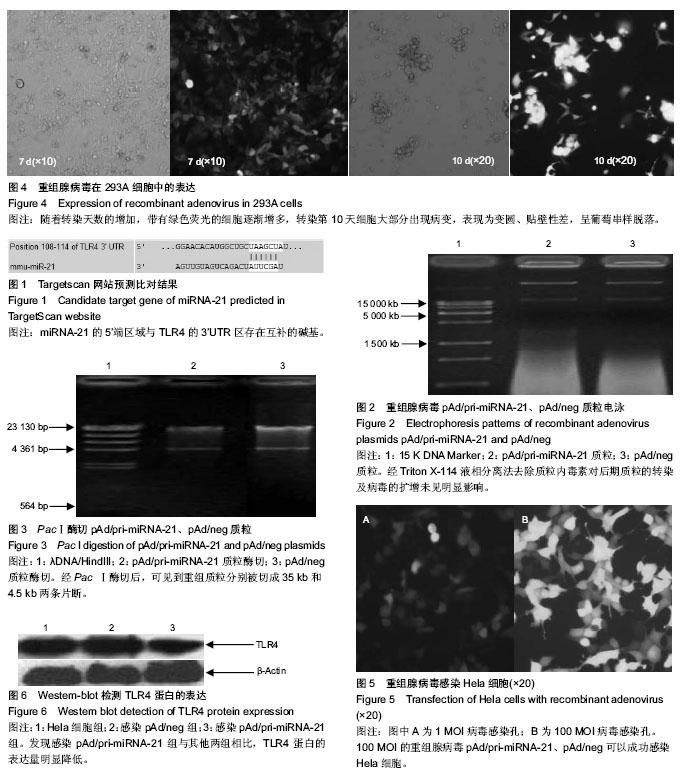| [1] Shukla GC, Singh J, Barik S.MicroRNAs: Processing, Maturation, Target Recognition and Regulatory Functions. Mol Cell Pharmacol.2011;3(3): 83-92.
[2] Bartel DP. MicroRNAs: target recognition and regulatory functions. Cell.2009;136(2):215-233.
[3] Jiang M, Zhang P, Hu G, et al. Relative expressions of miR-205-5p, miR-205-3p, and miR-21 in tissues and serum of non-small cell lung cancer patients. Mol Cell Biochem. 2013; 383 (1-2): 67-75.
[4] Kumar S, Keerthana R, Pazhanimuthu A,et al. Overexpression of circulating miRNA-21 and miRNA-146a in plasma samples of breast cancer patients. Indian J Biochem Biophys.2013;50(3):210-214.
[5] Pan X, Wang ZX, Wang R. MicroRNA-21: a novel therapeutic target in human cancer. Cancer Biol Ther.2010;10(12): 1224-1232.
[6] Carthew RW, Sontheimer EJ. Origins and Mechanisms of miRNAs and siRNAs. Cell. 2009;136 (4): 642-655.
[7] Sharma M,Juvvuna PK, Kukreti H, et al. Mega roles of microRNAs in regulation of skeletal muscle health and disease. Front Physiol.2014;5:239.
[8] Kim YJ, Park SJ, Choi EY, et al. PTEN modulates miR-21 processing via RNA-regulatory protein RNH1. PLoS One. 2011; 6 (12): e28308.
[9] Ludwig K,Fassan M, Mescoli C, et al. PDCD4/miR-21 dysregulation in inflammatory bowel disease-associated carcinogenesis. Virchows Arch.2013;462(1):57-63.
[10] Torres A, Torres K, Paszkowski T, et al. Highly increased maspin expression corresponds with up-regulation of miR-21 in endometrial cancer: a preliminary report. Int J Gynecol Cancer.2011;21(1):8-14.
[11] Ferraro A, Kontos CK, Boni T, et al.Epigenetic regulation of miR-21 in colorectal cancer: ITGB4 as a novel miR-21 target and a three-gene network (miR-21-ITGBeta4-PDCD4) as predictor of metastatic tumor potential. Epigenetics.2014;9(1): 129-141.
[12] Wang N, Zhang CQ, He JH, et al. MiR-21 down-regulation suppresses cell growth, invasion and induces cell apoptosis by targeting FASL, TIMP3, and RECK genes in esophageal carcinoma. Dig Dis Sci.2013;58(7):1863-1870.
[13] Vicinus B, Rubie C, Stegmaier N, et al. miR-21 and its target gene CCL20 are both highly overexpressed in the microenvironment of colorectal tumors: significance of their regulation. Oncol Rep.2013;30(3):1285-1292.
[14] 钟智伟.肺癌中miR-31miR-21对错配修复蛋白的调控以及对细胞增殖的影响[D].宁波大学, 2012.
[15] 包龙龙.miR-21调控肝癌细胞增殖转移分子机制的研究[D].苏州大学, 2013.
[16] Wang X, Gu J, Zhang MQ, Li Y. Identification of phylogenetically conserved microRNA cis-regulatory elements across 12 Drosophila species. Bioinformatics. 2008; 24(2):165-171.
[17] Gammell P. MicroRNAs: recently discovered key regulators of proliferation and apoptosis in animal cells : Identification of miRNAs regulating growth and survival. Cytotechnology. 2007; 53(1-3):55-63.
[18] Stark A, Brennecke J, Russell RB,et al. Identification of Drosophila MicroRNA targets. PLoS Biol.2003;1(3):E60.
[19] 张朵,李博,兰风华.以TritonX-114液相分离法去除质粒溶液中的内毒素[J].生物技术通讯, 2007,(6):0971-0902.
[20] Meng F, Henson R, Wehbe-Janek H, et al. MicroRNA-21 regulates expression of the PTEN tumor suppressor gene in human hepatocellular cancer. Gastroenterology, 2007;133(2): 647-658.
[21] Asangani IA, Rasheed SA, Nikolova DA,et al.MicroRNA-21 (miR-21) post-transcriptionally downregulates tumor suppressor Pdcd4 and stimulates invasion, intravasation and metastasis in colorectal cancer. Oncogene.2008;27(15): 2128-2136.
[22] Ren W, Qiang C, Gao L, et al. Circulating microRNA-21 (MIR-21) and phosphatase and tensin homolog (PTEN) are promising novel biomarkers for detection of oral squamous cell carcinoma. Biomarkers.2014;19(7): 590-596.
[23] Zhu S, Wu H, Wu F, et al. MicroRNA-21 targets tumor suppressor genes in invasion and metastasis. Cell Res. 2008; 18(3):350-359.
[24] Chen Y, Liu W, Chao T, et al. MicroRNA-21 down-regulates the expression of tumor suppressor PDCD4 in human glioblastoma cell T98G. Cancer Lett.2008;272(2):197-205.
[25] Schramedei K, Morbt N, Pfeifer G, et al. MicroRNA-21 targets tumor suppressor genes ANP32A and SMARCA4. Oncogene. 2011;30(26):2975-2985.
[26] Yao Q, Xu H, Zhang QQ, Zhou H,et al. MicroRNA-21 promotes cell proliferation and down-regulates the expression of programmed cell death 4 (PDCD4) in HeLa cervical carcinoma cells. Biochem Biophys Res Commun.2009;388 (3): 539-542. |
